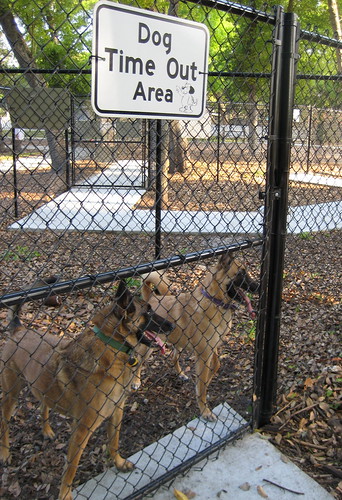It’s easy to smack a child or animal when they make you angry, or to yank a choke chain, but what results does physical punishment really yield? For many dog owners and parents alike, the only definite benefit of punishment is that it makes the person doing it feel as if they’ve done something to correct a problem, which alleviates anger and anxiety… for the punisher. For the one being punished, fear and anxiety are created. Once you realize that physical punishment is really only a lazy and ineffectual way to make the person doing it feel better, it’s easy to see that an alternative is necessary. For both dogs and children, time-outs can be that alternative, and are vastly more effective than hitting, spanking, yanking, or any other physical punishment, if applied correctly.
Why Lump Dogs and Kids Together?
Dogs and small children learn in similar ways. Both respond well to rewards and praise. Both easily shut down when overwhelmed or punished harshly. But most of all, both respond well to a behavioral approach to learning, as first articulated by Karen Pryor in Don’t Shoot the Dog. More often than not, if you’ve discovered a calm and positive training technique that works well for your dog, it’ll work for your child, too. That correlation doesn’t work the other way: For example, your dog probably won’t respond to verbal reasoning or a promise of a reward later for good behavior now.
Why Time-Outs?
If you’ve ever seen the television show “Super Nanny,” you’ve seen the Super Nanny herself picking up a child repeatedly and placing him on the ‘time-out spot’ without speaking a word. Like a good dog trainer, Super Nanny ignores unwanted behavior such as crawling away or screaming. She waits to give the reward of attention when the misbehaving child has calmed himself and sat politely in time-out for at least a few moments. Invariably, this approach soon yields results: Attention-getting misbehavior is reduced, and the child uses calm, polite behavior to get what he wants.
Why does this method work so well? It’s because both dogs and children crave attention and companionship, and to quietly remove them from these rewards makes more of an impact on their behavior than physical punishment or yelling. It is very distressing to kids or dogs accustomed to being in the thick of family activity to be separated from it, so a very brief time-out is long enough to convince them to reconsider behavior that results in this complete withdrawal of attention. The best part is, although it is an undesirable consequence, 30 to 90 seconds (as long as a time-out should be for a dog or small child) away from the family won’t cause the same side effects as punishment, like fear or rage. Some very out of control children may respond with anger when first placed in time out, but after the punishment and arguing that originally taught them to respond that way to correction are replaced with a quiet time-out, that anger will disappear.
When Time-Out Isn’t Working
If time-outs do nothing to impact your dog or child’s behavior, consider the following:
- Do you give enough rewards when the kid or dog isn’t in time-out? Lavish positive attention on dog or child who is behaving well.
- Do you refrain from speaking as you put the child or dog in time-out? Talking just takes away from the consequence of the withdrawal of your attention.
- Have you limited time-outs to a maximum of five minutes for kids and three minutes for dogs or toddlers? 30-90 seconds is even better for dogs and very young kids.
- Do you consistently give time-outs for the same behavior, regardless of circumstances?
- Is the child or dog getting proper nutrition, plenty of exercise, and structured playtime?


Irina
Что это за перевод??? Машинный, что ли?